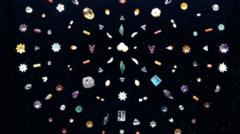The sale of these artifacts is reigniting discussions about the intersection of cultural heritage and commercial interests, particularly concerning the ethical stewardship of items intimately tied to India’s spiritual past.
On Wednesday, a stunning trove of jewels, identified as being connected to the Buddha's mortal remains, will be auctioned at Sotheby’s in Hong Kong. This collection, comprising nearly 1,800 pearls, rubies, and sapphires, has been regarded as one of the most significant archaeological discoveries, drawing attention from collectors and experts alike.
Unearthed in 1898 near Buddha's birthplace in present-day Uttar Pradesh, India, these relics reveal a complex history. They were discovered during an excavation by William Claxton Peppé, an English estate manager, who uncovered relics believed to be over 2,000 years old. Although much of the relics have been dispersed to various nations, including Thailand and Sri Lanka, the upcoming auction raises pressing questions surrounding the ethics of selling such sacred items.
Nicolas Chow, the chairman of Sotheby’s Asia, has called the discovery an "extraordinary archaeological revelation," but experts express concerns. Critics argue whether it's appropriate to sell treasures that hold deep cultural and spiritual significance to the Buddhist community. Naman Ahuja, an art historian, questions if the seller has any moral right to auction these relics, suggesting that they should be regarded as sacred rather than art for commerce.
Chris Peppé, the great-grandson of the original excavator, noted that his family considered various donation options for the relics but encountered challenges at every avenue. He argues that an auction could be the most equitable way to ensure these jewels reach the Buddhist community and be properly revered.
Experts in the field, Ashley Thompson and Conan Cheong, in a joint statement, express reservations about the ethics involved in trading human remains and highlight the complexity of defining what constitutes such remains. Their remarks resonate with many Buddhist leaders, with Amal Abeyawardene of the British MahaBodhi Society emphasizing the importance of preserving the relics for perpetuity rather than commodifying them.
Chris Peppé reflects on his family's connection to the relics, noting that while the historical context of their acquisition is complex and often tied to colonialism, their intention was to provide support for the local community. He believes that an auction represents a transparent manner of repatriating these items to the Buddhist faith.
As the auction date nears, sentiments about the sale remain mixed. Some scholars contend that the very act of auctioning such sacred articles continues a legacy of colonial exploitation, while others consider the potential benefits of legitimate ownership transfer. The relics' auction thus stands as a pivotal moment, posing essential questions about cultural heritage preservation and the moral obligations surrounding it amidst global discussions on repatriation and ownership of historic artifacts.
On Wednesday, a stunning trove of jewels, identified as being connected to the Buddha's mortal remains, will be auctioned at Sotheby’s in Hong Kong. This collection, comprising nearly 1,800 pearls, rubies, and sapphires, has been regarded as one of the most significant archaeological discoveries, drawing attention from collectors and experts alike.
Unearthed in 1898 near Buddha's birthplace in present-day Uttar Pradesh, India, these relics reveal a complex history. They were discovered during an excavation by William Claxton Peppé, an English estate manager, who uncovered relics believed to be over 2,000 years old. Although much of the relics have been dispersed to various nations, including Thailand and Sri Lanka, the upcoming auction raises pressing questions surrounding the ethics of selling such sacred items.
Nicolas Chow, the chairman of Sotheby’s Asia, has called the discovery an "extraordinary archaeological revelation," but experts express concerns. Critics argue whether it's appropriate to sell treasures that hold deep cultural and spiritual significance to the Buddhist community. Naman Ahuja, an art historian, questions if the seller has any moral right to auction these relics, suggesting that they should be regarded as sacred rather than art for commerce.
Chris Peppé, the great-grandson of the original excavator, noted that his family considered various donation options for the relics but encountered challenges at every avenue. He argues that an auction could be the most equitable way to ensure these jewels reach the Buddhist community and be properly revered.
Experts in the field, Ashley Thompson and Conan Cheong, in a joint statement, express reservations about the ethics involved in trading human remains and highlight the complexity of defining what constitutes such remains. Their remarks resonate with many Buddhist leaders, with Amal Abeyawardene of the British MahaBodhi Society emphasizing the importance of preserving the relics for perpetuity rather than commodifying them.
Chris Peppé reflects on his family's connection to the relics, noting that while the historical context of their acquisition is complex and often tied to colonialism, their intention was to provide support for the local community. He believes that an auction represents a transparent manner of repatriating these items to the Buddhist faith.
As the auction date nears, sentiments about the sale remain mixed. Some scholars contend that the very act of auctioning such sacred articles continues a legacy of colonial exploitation, while others consider the potential benefits of legitimate ownership transfer. The relics' auction thus stands as a pivotal moment, posing essential questions about cultural heritage preservation and the moral obligations surrounding it amidst global discussions on repatriation and ownership of historic artifacts.


















